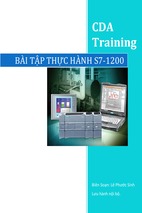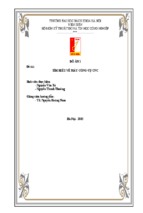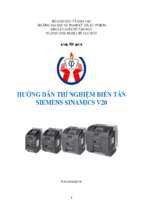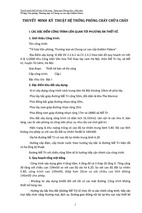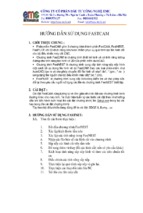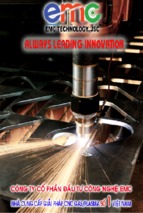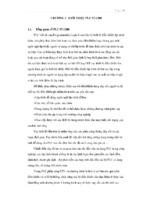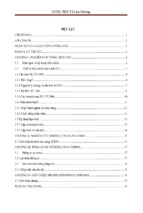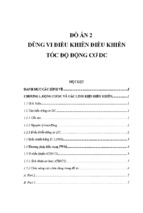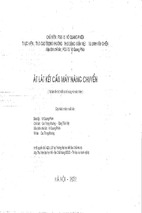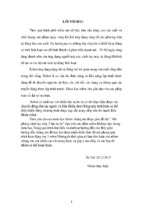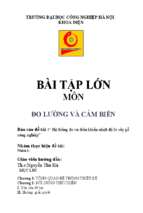DK3999_C000.fm Page i Thursday, October 26, 2006 6:12 AM
Applied
Pyrolysis
Handbook
Half Title Page
Second Edition
DK3999_C000.fm Page ii Thursday, October 26, 2006 6:12 AM
DK3999_C000.fm Page iii Thursday, October 26, 2006 6:12 AM
Applied
Pyrolysis
Handbook
Title Page
Second Edition
edited by
Thomas P. Wampler
Boca Raton London New York
CRC Press is an imprint of the
Taylor & Francis Group, an informa business
DK3999_C000.fm Page iv Thursday, October 26, 2006 6:12 AM
CRC Press
Taylor & Francis Group
6000 Broken Sound Parkway NW, Suite 300
Boca Raton, FL 33487-2742
© 2007 by Taylor & Francis Group, LLC
CRC Press is an imprint of Taylor & Francis Group, an Informa business
No claim to original U.S. Government works
Printed in the United States of America on acid-free paper
10 9 8 7 6 5 4 3 2 1
International Standard Book Number-10: 1-57444-641-X (Hardcover)
International Standard Book Number-13: 978-1-57444-641-8 (Hardcover)
This book contains information obtained from authentic and highly regarded sources. Reprinted
material is quoted with permission, and sources are indicated. A wide variety of references are
listed. Reasonable efforts have been made to publish reliable data and information, but the author
and the publisher cannot assume responsibility for the validity of all materials or for the consequences of their use.
No part of this book may be reprinted, reproduced, transmitted, or utilized in any form by any
electronic, mechanical, or other means, now known or hereafter invented, including photocopying,
microfilming, and recording, or in any information storage or retrieval system, without written
permission from the publishers.
For permission to photocopy or use material electronically from this work, please access www.
copyright.com (http://www.copyright.com/) or contact the Copyright Clearance Center, Inc. (CCC)
222 Rosewood Drive, Danvers, MA 01923, 978-750-8400. CCC is a not-for-profit organization that
provides licenses and registration for a variety of users. For organizations that have been granted a
photocopy license by the CCC, a separate system of payment has been arranged.
Trademark Notice: Product or corporate names may be trademarks or registered trademarks, and
are used only for identification and explanation without intent to infringe.
Library of Congress Cataloging-in-Publication Data
Applied Pyrolysis handbook / edited by Thomas Wampler. -- 2nd ed.
p. cm.
Includes bibliographical references and index.
ISBN-13: 978-1-57444-641-8 (alk. paper)
ISBN-10: 1-57444-641-X (alk. paper)
1. Pyrolysis--Handbooks, manuals, etc. I. Wampler, Thomas P., 1948- II. Title.
TP156.P9A67 2006
543--dc22
Visit the Taylor & Francis Web site at
http://www.taylorandfrancis.com
and the CRC Press Web site at
http://www.crcpress.com
2006023252
DK3999_C000.fm Page v Thursday, October 26, 2006 6:12 AM
Preface to the Second Edition
Analytical pyrolysis is the study of molecules by applying enough thermal energy
to cause bond cleavage, and then analyzing the resulting fragments by gas chromatography, mass spectrometry, or infrared spectroscopy. Pyrolysis has been employed
for the analysis of organic molecules for most of this century. It was initially connected with investigations of vapor-phase hydrocarbons and later became a routine
technique for analyzing fuel sources and natural and synthetic polymers. Current
applications include analysis of trace evidence samples in forensic laboratories,
evaluation of new composite formulations, authentication and conservation of artworks, identification of microorganisms, and the study of complex biological and
ecological systems. In the time since the first edition of this book, several significant
changes have occurred in the field of analytical pyrolysis. First, the introduction of
autosamplers for Py-gas chromatography-mass spectromety (GC/MS) has made the
technique more routine, more reproducible, and more acceptable for the analysis of
complex solids. Second, the widespread availability of mass spectrometers as detectors for Py-GC has led to a better understanding of the degradation products and the
processes that create them. Third, as mass spectrometry detectors have become more
sensitive, the application of analytical pyrolysis to trace-level determinations has
become routine, so that analysts may not only look at the matrix composition, but
also investigate additives such as plasticizers, antioxidants, and stabilizers.
This book is intended to be a practical guide to the application of pyrolysis
techniques to various samples and sample types. To that end, general and theoretical
considerations, including instrumentation and degradation mechanisms, have been
consolidated in the first two chapters. The balance of the book describes the use of
pyrolysis as a tool in specific fields. Synthetic polymers, forensic materials, and other
samples with a long history of analysis by pyrolysis are covered. In addition, we
have been pleased to see some new areas of study, such as the analysis of surfactants,
antiquities, and environmental materials, and these topics are presented as well.
The chapters examine the scope of work based on pyrolysis in particular fields
of analysis and give specific examples of methods currently used for the examination
of representative samples. This book is intended to serve as a starting point for
analysts who are adding pyrolysis to their array of analytical techniques by providing concrete examples and suggesting additional reading.
I thank all of the authors for their contributions. With only a few exceptions,
the authors of the chapters in the first edition agreed to update the chapters they
wrote, adding recent examples and references. Each is actively involved in scientific
pursuits, and the time that they have taken away from their busy schedules to
contribute to this project was valuable and greatly appreciated.
Thomas P. Wampler
DK3999_C000.fm Page vi Thursday, October 26, 2006 6:12 AM
DK3999_C000.fm Page vii Thursday, October 26, 2006 6:12 AM
The Editor
Thomas P. Wampler has been actively engaged in the field of analytical pyrolysis
for 25 years. He is director of science and technology at CDS Analytical, Inc., in
Oxford, Pennsylvania. He is the author or coauthor of numerous professional papers
on the use of analytical pyrolysis and other thermal sampling techniques. He received
a B.S. degree (1970) in chemistry and a M.Ed. degree (1973) in natural science from
the University of Delaware, Newark.
DK3999_C000.fm Page viii Thursday, October 26, 2006 6:12 AM
DK3999_C000.fm Page ix Thursday, October 26, 2006 6:12 AM
Contributors
Norbert S. Baer
Conservation Center
New York University
New York, New York
John M. Challinor
Chemistry Centre (WA)
East Perth, Western Australia
Randolph C. Galipo
University of South Carolina
Columbia, South Carolina
Karen Jansson
CDS Analytical, Inc.
Oxford, Pennsylvania
C.J. Maddock
Horizon Instruments Ltd.
Heathfleld, East Sussex, England
Stephen L. Morgan
University of South Carolina
Columbia, South Carolina
T.O. Munson
Department of Math/Science
Concordia University
Portland, Oregon
Hajime Ohtani
Nagoya Institute of Technology
Nagoya, Japan
T.W. Ottley
Horizon Instruments Ltd.
Heathfleld, East Sussex, England
Alexander Shedrinsky
Chemistry and Biochemistry
Department
Long Island University
Brooklyn, New York
Shin Tsuge
Nagoya University
Nagoya, Japan
Thomas P. Wampler
CDS Analytical, Inc.
Oxford, Pennsylvania
Bruce E. Watt
University of South Carolina
Columbia, South Carolina
Charles Zawodny
CDS Analytical, Inc.
Oxford, Pennsylvania
DK3999_C000.fm Page x Thursday, October 26, 2006 6:12 AM
DK3999_book.fm Page xi Tuesday, October 24, 2006 7:17 AM
Contents
Chapter 1
Analytical Pyrolysis: An Overview .....................................................1
Thomas P. Wampler
Chapter 2
Instrumentation and Analysis.............................................................27
Thomas P. Wampler
Chapter 3
Pyrolysis Mass Spectrometry: Instrumentation, Techniques,
and Applications .................................................................................47
C.J. Maddock and T.W. Ottley
Chapter 4
Microstructure of Polyolefins ............................................................65
Shin Tsuge and Hajime Ohtani
Chapter 5
Degradation Mechanisms of Condensation Polymers:
Polyesters and Polyamides .................................................................81
Hajime Ohtani and Shin Tsuge
Chapter 6
The Application of Analytical Pyrolysis to the Study of
Cultural Materials.............................................................................105
Alexander Shedrinsky and Norbert S. Baer
Chapter 7
Environmental Applications of Pyrolysis ........................................133
T.O. Munson
Chapter 8
Examination of Forensic Evidence ..................................................175
John M. Challinor
Chapter 9
Characterization of Microorganisms by Pyrolysis-GC,
Pyrolysis-GC/MS, and Pyrolysis-MS ..............................................201
Stephen L. Morgan, Bruce E. Watt, and Randolph C. Galipo
DK3999_book.fm Page xii Tuesday, October 24, 2006 7:17 AM
Chapter 10 Analytical Pyrolysis of Polar Macromolecules ...............................233
Charles Zawodny and Karen Jansson
Chapter 11 Characterization of Condensation Polymers by Pyrolysis-GC
in the Presence of Organic Alkali ....................................................249
Hajime Ohtani and Shin Tsuge
Chapter 12 Index of Sample Pyrograms ............................................................271
Thomas P. Wampler
Index......................................................................................................................285
DK3999_book.fm Page 1 Tuesday, October 24, 2006 7:17 AM
1
Analytical Pyrolysis:
An Overview
Thomas P. Wampler
CONTENTS
1.1
1.2
Introduction ......................................................................................................1
Degradation Mechanisms.................................................................................2
1.2.1 Random Scission..................................................................................2
1.2.2 Side Group Scission.............................................................................5
1.2.3 Monomer Reversion.............................................................................6
1.2.4 Relative Bond Strengths ......................................................................6
1.2.4.1 Polyolefins.............................................................................7
1.2.4.2 Vinyl Polymers .....................................................................8
1.2.4.3 Acrylates and Methacrylates ................................................8
1.3 Examples and Applications..............................................................................9
1.3.1 Forensic Materials................................................................................9
1.3.2 Fibers and Textiles .............................................................................11
1.3.3 Paper, Ink, and Photocopies...............................................................13
1.3.4 Art Materials and Museum Pieces ....................................................16
1.3.5 Synthetic Polymers ............................................................................18
1.3.6 Natural Materials and Biologicals .....................................................19
1.3.7 Paints and Coatings............................................................................22
1.3.8 Trace-Level Analyses .........................................................................22
References................................................................................................................24
1.1 INTRODUCTION
Pyrolysis, simply put, is the breaking apart of chemical bonds by the use of thermal
energy only. Analytical pyrolysis is the technique of studying molecules either by
observing their behavior during pyrolysis or by studying the resulting molecular
fragments. The analysis of these processes and fragments tells us much about the
nature and identity of the original larger molecule. The production of a variety of
smaller molecules from some larger original molecule has fostered the use of pyrolysis as a sample preparation technique, extending the applicability of instrumentation
designed for the analysis of gaseous species to solids, especially polymeric materials.
As a result, gas chromatography, mass spectrometry, and Fourier-transform infrared
1
DK3999_book.fm Page 2 Tuesday, October 24, 2006 7:17 AM
2
Applied Pyrolysis Handbook, Second Edition
(FT-IR) spectrometry may be used routinely for the analysis of samples such as
synthetic polymers, biopolymers, composites, and complex industrial materials.
The fragmentation that occurs during pyrolysis is analogous to the processes
that occur during the production of a mass spectrum. Energy is put into the system,
and as a result, the molecule breaks apart into stable fragments. If the energy
parameters (temperature, heating rate, and time) are controlled in a reproducible
way, the fragmentation is characteristic of the original molecule, based on the relative
strengths of the bonds between its atoms. The same distribution of smaller molecules
will be produced each time an identical sample is heated in the same manner, and
the resulting fragments carry with them much information concerning the arrangement of the original macromolecule.
The application of pyrolysis techniques to the study of complex molecular
systems covers a wide and diversified field. Several books have been published that
present theoretical as well as practical aspects of the field, including a good introductory text by Irwin1 and a compilation of gas chromatographic applications by
Liebman and Levy.2 A 1989 bibliography3 lists approximately 500 papers in areas
as diverse as food and environmental and geochemical analysis, an excellent review
by Blazsó4 lists over 150 papers just in the analysis of polymers, and the application
to microorganisms has been examined by Morgan et al.5 This chapter will include
only a few representational examples of the kinds of applications being pursued,
with references for further reading. Specific areas of analysis are detailed in subsequent chapters.
1.2 DEGRADATION MECHANISMS
The degradation of a molecule that occurs during pyrolysis is caused by the dissociation
of a chemical bond and the production of free radicals. The general processes employed
to explain the behavior of these molecules are based on free radical degradation
mechanisms. The way in which a molecule fragments during pyrolysis and the identity
of the fragments produced depend on the types of chemical bonds involved and the
stability of the resulting smaller molecules. If the subject molecule is based on a carbon
chain backbone, such as that found in many synthetic polymers, it may be expected
that the chain will break apart in a fairly random fashion to produce smaller molecules
chemically similar to the parent molecule. Some of the larger fragments produced will
preserve intact structural information snipped out of the polymer chain, and the kinds
and relative abundances of these specific smaller molecules give direct evidence of
macromolecular structure. The traditional degradation mechanisms generally applied
to explain the pyrolytic behavior of macromolecules will now be reviewed, followed
by some general comments on degradation via free radicals.
1.2.1 RANDOM SCISSION
Breaking apart a long-chain molecule such as the carbon backbone of a synthetic
polymer into a distribution of smaller molecules is referred to as random scission.
If all of the C—C bonds are of about the same strength, there is no reason for one
to break more than another, and consequently, the polymer fragments to produce a
DK3999_book.fm Page 3 Tuesday, October 24, 2006 7:17 AM
Analytical Pyrolysis: An Overview
3
wide array of smaller molecules. The polyolefins are good examples of materials
that behave in this manner. When poly(ethylene) (shown as structure I, with hydrogen
atoms left off for simplicity) is heated sufficiently to cause pyrolysis, it breaks apart
into hydrocarbons, which may contain any number of carbons, including methane,
ethane, propane, etc.
I
II
—C—C—C—C—C—C—
—C—C— C •
• C—C— C—
Chain scission produces hydrocarbons with terminal free radicals (structure II),
which may be stabilized in several ways. If the free radical abstracts a hydrogen
atom from a neighboring molecule, it becomes a saturated end and creates another
free radical in the neighboring molecule (structure III), which may stabilize in a
number of ways. The most likely of these is beta scission, which accounts for most
of the polymer backbone degradation by producing an unsaturated end and a new
terminal free radical.
III
•
—C—C—C—C—C—C—
Beta scission
IV
—C—C—C = CH2
+
•C—C—
This process continues, producing hydrocarbon molecules that are saturated and
have one terminal double bond or a double bond at each end. When analyzed by
gas chromatography, the resulting pyrolysate looks like the bottom chromatogram
in Figure 1.1. Each triplet of peaks represents the diene, alkene, and alkane containing a specific number of carbons and eluting in that order. The next set of three
peaks contain one more carbon, etc. It is typical to see all chain lengths from methane
to compounds containing 35 to 40 carbons, limited only by the upper temperature
of the gas chromatography (GC) column.
When poly(propylene) is pyrolyzed, it behaves in much the same manner, producing a series of hydrocarbons that have methyl branches indicative of the structure
of the original polymer. The center pyrogram in Figure 1.1 shows poly(propylene),
revealing again a recurring pattern of peaks, with each group now containing three
more carbons than the preceding group. Likewise, when a polymer made from a
four-carbon monomer such as 1-butene is pyrolyzed, it produces yet another pattern
of peaks, with oligomers differing by four carbons, as seen in the top pyrogram in
Figure 1.1. The relationships of specific compounds produced in the pyrolysate to
the original polymer structure have been extensively studied by Tsuge et al.,6 for
example, in the case of poly(propylenes). The effects of temperature and heating
rate have also been studied.7
DK3999_book.fm Page 4 Tuesday, October 24, 2006 7:17 AM
4
Applied Pyrolysis Handbook, Second Edition
10
5.00
10.00
14
15.00
20.00
25.00
30.00
35.00
40.00
FIGURE 1.1 Pyrograms of poly(1-butene) (top), poly(propylene) (center), and poly(ethylene) (bottom).
DK3999_book.fm Page 5 Tuesday, October 24, 2006 7:17 AM
Analytical Pyrolysis: An Overview
5
Abundance
2.5e+07
2.4e+07
2.3e+07
2.2e+07
2.1e+07
2e+07
1.9e+07
1.8e+07
1.7e+07
1.6e+07
1.5e+07
1.4e+07
1.3e+07
1.2e+07
1.1e+07
1e+07
9000000
8000000
7000000
6000000
5000000
4000000
3000000
2000000
1000000
0
Time-->
2
1
4
3
2.00
4.00
6.00
8.00
10.00
12.00
14.00
16.00
18.00
FIGURE 1.2 Pyrogram of poly(vinyl chloride) at 750°C for 15 seconds. Peaks: 1 = HCl, 2
= benzene, 3 = toluene, 4 = naphthalene.
1.2.2 SIDE GROUP SCISSION
When poly(vinyl chloride) (PVC) is pyrolyzed, no such oligomeric pattern occurs.
Instead of undergoing random scission to produce chlorinated hydrocarbons, PVC
produces aromatics, especially benzene, toluene, and naphthalene, as shown in
Figure 1.2. This is the result of a two-step degradation mechanism that begins with
the elimination of HCl from the polymer chain (structure V), leaving the polyunsaturated backbone shown as structure VI.
V
Cl
H
Cl
H
Cl
H
|
|
|
|
|
|
—C — C — C — C — C — C—
— HC1
VI
—C = C — C = C — C = C—
Upon further heating, this unsaturated backbone produces the characteristic
aromatics seen in the pyrogram. This mechanism has been well characterized, and
the occurrence of chlorinated aromatics is used as an indication of polymer defect
structures, as in the work of Lattimer and Kroenke.8
DK3999_book.fm Page 6 Tuesday, October 24, 2006 7:17 AM
6
Applied Pyrolysis Handbook, Second Edition
1.2.3 MONOMER REVERSION
A third pyrolysis behavior is evidenced by polymers such as poly(methyl methacrylate). Because of the structure of methacrylate polymers (structure VII), the favored
degradation is essentially a reversion to the monomer.
VII
CH3
CH3
CH3
|
H
|
H
|
-C — C — C — C — C •
|
H
|
H
|
CO2R
CO2R
CO2R
Beta Scission
CH3
CH3
|
H
|
—C — C — C •
+
|
H
|
CO2R
CO2R
CH3
|
CH2 = C
|
CO2R
Monomer
Monomer production is for the most part unaffected by the R group, so that
poly(methyl methacrylate) will revert to methyl methacrylate, poly(ethyl methacrylate) will produce ethyl methacrylate, etc. This proceeds in copolymers as well, with
the production of both monomers in roughly the original polymerization ratio. Figure
1.3 shows a pyrogram of poly(butyl methacrylate), with the butyl methacrylate
monomer peak by far the predominant product. A pyrogram of a copolymer of two
or more methacrylate monomers would contain a peak for each of the monomers
in the polymer.
1.2.4 RELATIVE BOND STRENGTHS
The question of which degradation mechanism a particular polymer will be subjected to — random scission, side group scission, monomer reversion, or a combination of these — is simplified by considering the nature of thermal degradation as
a free radical process. All of the degradation products shown, as well as minor
constituents, and deviations to the simplified rules are consistent with the following
general statements:
Pyrolysis degradation mechanisms are free radical processes and are initiated
by breaking the weakest bonds first.
The composition of the pyrolysate will be based on the stability of the free
radicals involved and on the stabilities of the product molecules.
Free radical stability follows the usual order of 3° > 2° > 1° > CH3, and
intramolecular rearrangements, which produce more stable free radicals,
play an important role, particularly the shift of a hydrogen atom.
DK3999_book.fm Page 7 Tuesday, October 24, 2006 7:17 AM
Analytical Pyrolysis: An Overview
7
Abundance
1.6e+07
1.5e+07
1.4e+07
1.3e+07
1.2e+07
1.1e+07
1e+07
9000000
8000000
7000000
6000000
5000000
4000000
3000000
2000000
1000000
0
Time-->
5.00
10.00
15.00
20.00
25.00
30.00
35.00
FIGURE 1.3 Pyrogram of poly(butyl methacrylate), showing large monomer peak (750°C
for 15 seconds).
A quick review of the previous degradation examples will help show how each
of the above categories is in reality just one aspect of the general rule of free radical
processes.
1.2.4.1 Polyolefins
Poly(ethylene) and the other polyolefins contain only C—C bonds and C—H bonds.
Since an average C—C bond is about 83 kcal/mole and a C—H bond 94 kcal/mole,
the initiation step involves breaking the backbone of the molecule, with subsequent
stabilization of the free radical. In the case of poly(ethylene), the original free
radicals formed are terminal or primary. Hydrogen abstraction from a neighboring
molecule creates a C—H bond (stable product) and a new, secondary free radical,
which may then undergo beta scission to form an unsaturated end. In addition,
transfer of a hydrogen atom from the carbon 5 removed from the free radical (via
a six-membered ring) transforms a primary free radical to a secondary, increasing
the free radical stability.
H
/
-----C5
|
C4
\
1C •
|
2C
/
C3
H
\
C
|
C
/
-----C •
|
C
\
C
- Xem thêm -


